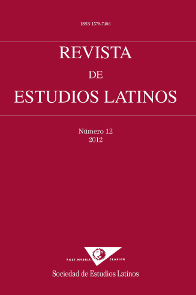The predicative frame of the verb persuadeo in latin: a revision
DOI:
https://doi.org/10.23808/rel.v12i0.87789Keywords:
functionalism; predicative framework; semantic; syntax.Abstract
The objective of this essay is to review the predicative frame of the verb persuadeo in classical and postclassical Latin, as well as the functional characterization of its constituents. Well, following the theoretical principles functionalism of Dik and having analyzed a large corpus of authors (Caesar, Sallust, Nepos, Cicero, Livy, Seneca, Petronius and Apuleius), lead to the conclusion that this verb, at least in the analyzed synchronies, is an intransitive trivalent verb, whose arguments carry out in the active sentence syntactic functions of subject, indirect complement and supplement with the respective semantic functions of agent, target and reference, which from the postclassic period undergroes a process of «transitivation» to avoid unnecessary semantic redundancy between the verbal lexeme and the third argument, which will give place to the predicative frame presented in Spanish.
Downloads
References
Alarcos, E. 1984: Estudios de gramática funcional del español, Gredos, Madrid.
Alarcos, E. 2001: Gramática de la Lengua Española, Espasa, Madrid.
Baños, J.M. (coord.) 2009: Sintaxis del latín clásico, Madrid, Liceus.
Berdasco, J.C. 2009: «Caracterización funcional del sintagma preposicional de + ablativo en latín clásico», Pectora Mulcet. Estudios de Retórica y Oratoria Latinas, 2 Vols. (Arcos, T.-Fernández, J.-Moya, F. eds.), Logroño, 171-182.
Dik, S. 1978: Functional Grammar, Amsterdam, North-Holland.
— 1997: The Theory of Functional Grammar I. Part I: The Structure of de Clause, Berlín-New York, de Gruyter.
García Hernández, B. 1995: «El dativo latino: Funciones e interferencias sintácticas y semánticas», Sintaxis del dativo latino (Torrego, E.-Quetglas, P.-Espinilla, E. eds.), Barcelona, 35-50.
Jiménez López, M. D. 2006: «Persuadir en griego: el marco predicativo de πείϑω», Word Classes and Related Topics in Ancient Greek, (Crespo, E.-Villa de la, J.-Revuelta, A. eds.), Louvain-La-Neuve, 163-191.
Lehmann, Ch. 2006: «Participant roles, thematic roles and syntactic relations», Voice and grammatical relations. Festschrift for Masayoshi Shibatani, (Tsumoda, T. & Kageyama, T. eds.), Amsterdam - Philadelphia, 167-190.
Martínez García, H. 1986: El suplemento en español, Madrid, Gredos.
Moralejo, J.L. 1986: «Sobre los casos latinos», RSEL 16, 1, 293-323.
— 1995: «El dativo regido como complemento único», Sintaxis del dativo latino (Torrego, E.-Quetglas, P.-Espinilla, E. eds.), Barcelona, 95-104.
Pinkster, H. 1985: «Latin cases and valency grammar: some problems», Touratier, Ch. (ed.), 163-189.
— 1995: Sintaxis y Semántica del Latín, Ediciones Clásicas, Madrid.
Rubio, L. 1984: Introducción a la sintaxis estructural del latín, Ariel, Barcelona.
Suárez Martínez, P.M., 2002: «Subordinación o coordinación con quam?». La comparación en latín, (Espinilla, E.-Quetglas, P.-Torrego, E. eds.), Barcelona, 229-249.
Serbat, G. 1982: «Le système casuel est-il systématique?», REL 59, 298-317.
— 1988: Casos y funciones, Gredos, Madrid.
Tarriño, E., 2007: «Sobre la construcción de suadeo y persuadeo», Praedicativa II: Esquemas de complementación verbal en griego antiguo y en latín (Baños, J. M.-Cabrillana, C.-Méndez, J.-Torrego, E. eds.), Zaragoza, 211-232.
Van Valin, R. y La Polla, R.J. 1997: Syntax. Structure, Meaning an Function, Cambridge.
Villa de la, J. 1989: «Las funciones de los elementos nominales: criterios para su identificación y caracterización en griego y en latín», CFC 22, 291-303.
— 2003: «Límites y alternancias de los marcos predicativos», Praedicativa. Complementación en griego y latín, Verba, Anejo 53 (Baños, J. M.-Cabrillana, C.-Torrego, M. E.-Villa de la, J. eds.), Santiago de Compostela.
Downloads
Published
How to Cite
Issue
Section
License
Copyright (c) 2012 Revista de Estudios Latinos

This work is licensed under a Creative Commons Attribution-NonCommercial-NoDerivatives 4.0 International License.
The originals published in the printed and electronic editions of this journal are the property of the Revista de Estudios Latinos and can be circulated as long as the original source and authorship is made clear in any reproduction, full or partial, of the same, and as long as this is not done for commercial purposes.








